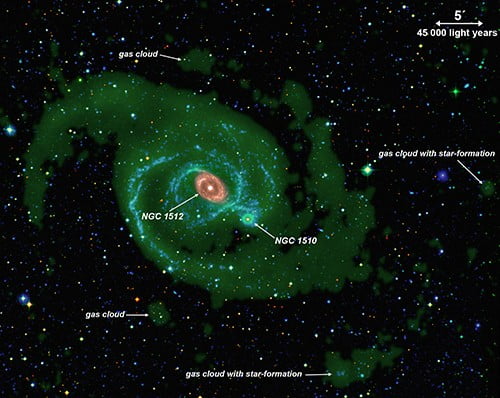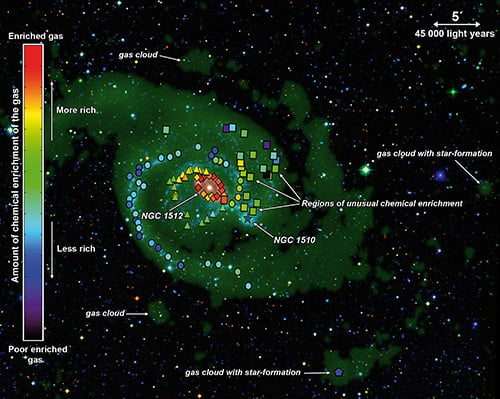Galaxy’s snacking habits revealed
A team of Australian and Spanish astronomers have caught a greedy galaxy gobbling on its neighbours and leaving crumbs of evidence about its dietary past.
Galaxies grow by churning loose gas from their surroundings into new stars, or by swallowing neighbouring galaxies whole. However, they normally leave very few traces of their cannibalistic habits.
A study published today in Monthly Notices of the Royal Astronomical Society (MNRAS) not only reveals a spiral galaxy devouring a nearby compact dwarf galaxy, but shows evidence of its past galactic snacks in unprecedented detail.
Australian Astronomical Observatory (AAO) and Macquarie University astrophysicist, Ángel R. López-Sánchez, and his collaborators have been studying the galaxy NGC 1512 to see if its chemical story matches its physical appearance.
The team of researchers used the unique capabilities of the 3.9-metre Anglo-Australian Telescope (AAT), near Coonabarabran, New South Wales, to measure the level of chemical enrichment in the gas across the entire face of NGC 1512.
Chemical enrichment occurs when stars churn the hydrogen and helium from the Big Bang into heavier elements through nuclear reactions at their cores. These new elements are released back into space when the stars die, enriching the surrounding gas with chemicals like oxygen, which the team measured.
“We were expecting to find fresh gas or gas enriched at the same level as that of the galaxy being consumed, but were surprised to find the gases were actually the remnants of galaxies swallowed earlier,” Dr López-Sánchez said.
“The diffuse gas in the outer regions of NGC 1512 is not the pristine gas created in the Big Bang but is gas that has already been processed by previous generations of stars.”
CSIRO’s Australia Telescope Compact Array, a powerful 6-km diameter radio interferometer located in eastern Australia, was used to detect large amounts of cold hydrogen gas that extends way beyond the stellar disk of the spiral galaxy NGC 1512.
“The dense pockets of hydrogen gas in the outer disk of NGC 1512 accurately pin-point regions of active star formation”, said CSIRO’s Dr Baerbel Koribalski, a member of the research collaboration.
When this finding was examined in combination with radio and ultraviolet observations the scientists concluded that the rich gas being processed into new stars did not come from the inner regions of the galaxy either. Instead, the gas was likely absorbed by the galaxy over its lifetime as NGC 1512 accreted other, smaller galaxies around it.
Dr Tobias Westmeier, from the International Centre for Radio Astronomy Research in Perth, said that while galaxy cannibalism has been known for many years, this is the first time that it has been observed in such fine detail.
“By using observations from both ground and space based telescopes we were able to piece together a detailed history for this galaxy and better understand how interactions and mergers with other galaxies have affected its evolution and the rate at which it formed stars,” he said.
The team’s successful and novel approach to investigating how galaxies grow is being used in a new program to further refine the best models of galaxy evolution.
For this work the astronomers used spectroscopic data from the AAT at Siding Spring Observatory in Australia to measure the chemical distribution around the galaxies. They identified the diffuse gas around the dual galaxy system using Australian Telescope Compact Array (ATCA) radio observations. In addition, they identified regions of new star formation with data from the Galaxy Evolution Explorer (GALEX) orbiting space telescope.
“The unique combination of these data provide a very powerful tool to disentangle the nature and evolution of galaxies,” said Dr López-Sánchez.
“We will observe several more galaxies using the same proven techniques to improve our understanding of the past behaviour of galaxies in the local Universe.”
Images:
The below images are available in highest resolution on Dropbox.

Multiwavelength image of galaxies NGC 1512 and NGC 1510 combining optical and near-infrared data (light blue, yellow, orange), ultraviolet data (dark blue), mid-infrared data (red), and radio data (green).

A chemical enrichment map of the NGC 1512 and NGC 1510 galaxy system showing the amount of oxygen gas in the star-forming regions around the two galaxies.
Publication details:
Á. R. López-Sánchez, T. Westmeier, C. Esteban, and B. S. Koribalski.“Ionized gas in the XUV disc of the NGC1512/1510 system”. Published in Monthly Notices of the Royal Astronomical Society (MNRAS) through Oxford University Press.
Science Team contacts:
Dr Ángel R. López-Sánchez
Australian Astronomical Observatory / Macquarie University
Ph: +61 2 9372 4898
M: +61 406 265 917
E: angel.lopez-sanchez@aao.gov.au
Dr Tobias Westmeier
The International Centre for Radio Astronomy Research / University of Western Australia
Ph: +61 8 6488 4592
M: (call Pete Wheeler)
E: tobias.westmeier@icrar.org
Dr Baerbel Koribalski
Commonwealth Scientific and Industrial Research Organisation (CSIRO)
Ph: +61 2 9372 4361
M: +61 450 624 954
E: baerbel.koribalski@csiro.au
Press Officer contacts
Dr Amanda Bauer
Australian Astronomical Observatory (AAO)
Ph: +61 2 9372 4852
M: +61 447 029 368
E: amanda.bauer@aao.gov.au
Pete Wheeler
The International Centre for Radio Astronomy Research (ICRAR)
Ph: +61 8 6488 7758
M: +61 0423 982 018
E: pete.wheeler@icrar.org

